
FOUR IMPORTANT
SAN JUAN BASIN FORMATIONS
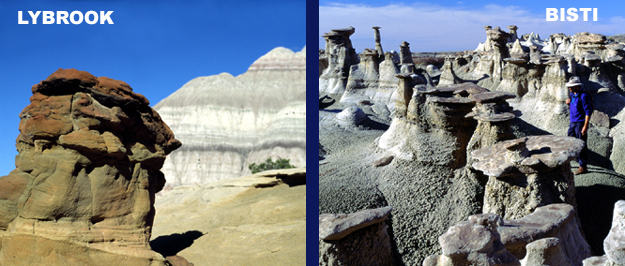
SNAP SHOTS OF THE DINOSAUR EXTINCTION
Seven of the nine badlands are carved from just 4 contiguous San Juan Basin formations. The Fruitland, Kirtland, Ojo Alamo, and Nacimiento formations span that fabled snapshot of geologic time in the fossil record known as the K-T boundary. This 65 million year old “Cretaceous / Tertiary boundary” marks the sudden dinosaur extinction, an ongoing mystery which still sparks considerable scientific debate. The Fruitland/Kirtland formations, at 75 to 70 million years old in the late Cretaceous, lie on the dinosaur side of the boundary, while the 65 or 64 to 58 million year old Nacimiento formation in the early Paleocene, definitely lies on the mammal side. The problem is with the exact times for the Ojo Alamo formation.
The theory that rapid dinosaur extinction followed a gigantic meteor impact was corroborated by the discovery of a thin but distinct deposit of the element Iridium in sedimentary layers lying exactly at the 65 million year old K-T boundary line. Iridium is very rare on earth but common in meteors. Unfortunately, there are only a few places on Earth where terrestrially deposited layers actually record this brief, cataclysmic time span. Paleontologists disagree as to whether the San Juan Basin is one of them.
A relatively brief unconformity, and resulting break in the basin’s fossil record occurs between the Kirtland and Ojo Alamo formations at the end of the Cretaceous. The diagram shows the Ojo Alamo in the Paleocene, but geologists question these depositional times. If it’s part of the late Cretaceous, it spans the K-T Boundary; if it’s part of the Paleocene, it was deposited after the cataclysmic event. No Iridium has been found in the Ojo Alamo, yet there are claims of dinosaur fossil finds.
Think of it as just another riddle, more hints of a Cosmic Sense of Humor at work in the badlands.
One way or the other, the San Juan Basin fossil record begins again immediately after the K-T boundary in the early Paleocene, as mammals were just beginning to evolve in complexity and diversity prior to their Eocene explosion.
ANCIENT DEPOSITIONAL ENVIRONMENTS AND BADLAND’S TOPOGRAPHY
Ancient depositional environments for all four formations were generally the same fertile, wet, lowlands that prevailed during most of the basin’s 200 million year history but with subtle differences. Badlands have two basic hoo doo “styles” depending on which sedimentary rocks they’re formed from.
Classic “mushroom” shaped, shale/siltstone, Bisti type hoo doos are smaller, more numerous, and often packed together by the hundreds into intricate, multi-chambered labyrinths. They have rich textures and a weirdly organic look. Their precariously balanced, fragile cap rocks tend to be smoothly contoured and aerodynamically designed.
Tougher sandstone hoo doos come in more diverse shapes, are usually larger, more sharply defined and colorful. They often include delicate arches and clusters of finely etched domes. Cap rocks can also be quite large, more angular and less obviously wind polished.
The 3 Fruitland/Kirtland badlands, the Bisti, De Na Zin and Ah Shi Sle Pah, share definite similarities in topography, color schemes, and “hoo doo styles” as do the 3 Nacimiento badlands, Lybrook, Penistaja, and CejaPelon. Predictably, these two badland groups differ from each other due to different sedimentary rocks in their respective formations.
The De Na Zin Wilderness, which begins in the Fruitland formation and includes all 4 formations up to the Nacimiento, actually spans the K-T boundary and shows great diversity in topography and hoo doo styles. Mesa De Cuba lies in both the Nacimiento and younger San Jose formations, with a distinctive topography all its own.
THE FRUITLAND/ KIRTLAND BADLANDS:
BISTI, DE NA ZIN, and AH SHI SLE PAH
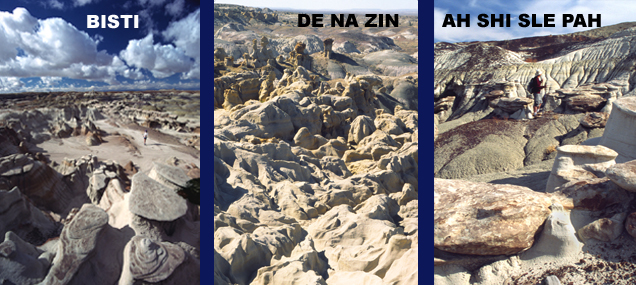
The Fruitland/Kirtland formations were part of a huge river delta along the shoreline of an ancient, retreating inland sea. This was the last of several Cretaceous “seaways” which grew south from Canada all the way to Mexico, inundating the Midwest and parts of the southwest, before retreating back north.
Rock types in the Fruitland/Kirtland formations consist mainly of relatively homogeneous, finer-grained siltstones and shales formed from delta and flood plain deposits. Fossils show that both fresh and salt water species lived close together and even intermingled in brackish swamps and bayous.
The Bisti, De Na Zin and Ah Shi Sle Pah badlands occur where extensive arroyo networks have carved deeply down into fairly level layers. The general topography is that of a giant, multi-branching, dry wash maze with relatively little vertical relief: you’re either down in the wash or up on the rim. Almost monochromatic color schemes include predominately browns, beiges, grays, charcoals, and blacks with muted yellow, orange, reds, purples, and green accent colors.
The Bisti and De Na Zin have few erosion resistant sandstone mesa edges. Instead they contain widespread brilliant, red layers where ancient underground coal fires created brittle, iron oxide colored “ceramics” from surrounding siltstone and shale in a manner analogous to a giant pottery kiln.
Lower elevation Bisti and Ah Shi Sle Pah badlands contain classic shale/siltstone hoo doos literally by the thousands. Harder coal fired ceramics layers create hoo doos more like sand stone types. Bisti has extensive sections of these “clinkers” as geologists name the ceramics. De Na Zin has large Ojo Alamo sections where huge rust colored cap rocks sit atop thick crenulated bases. Large petrified logs form cap rocks and even arch tops.
THE NACIMIENTO BADLANDS:
LYBROOK, CEJA PELON, PENISTAJA
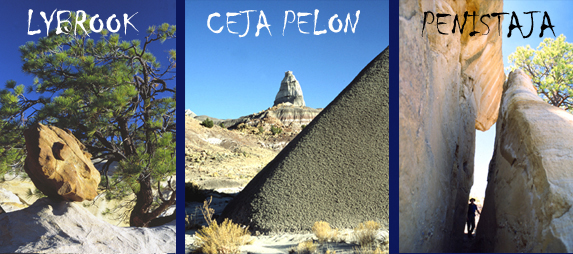
The more complex Nacimiento formation was deposited in a “terrestrial” wetlands environment of rivers, streams, flood plains, lakes, and bogs. Copious sediments, washed downstream out from the rapidly rising, present day San Juan Mountains just to the north, included everything from gravel, sand, soil, clay, and rich organic materials, along with regular additions from volcanic ash showers.
Nacimiento Badlands, Lybrook, Ceja Pelon, and Penistaja, along with Mesa De Cuba show considerable vertical relief ranging from 500 to 1000 feet. Sub layers of erosion resistant sandstone alternating with softer siltstone and shale form distinct stair step mesas. Tough red and gold sandstone makes up mesa edges, while grey and white side walls are of softer shale and siltstone with black coal bands. Two distinctly different hoo doo styles occur at alternating levels. Long thin projecting fingers of mesa are separated by deep, precipitous box canyons. Continuous sandstone hoo doos line top edges while intricate, siltstone mushroom gardens, complete with shallow caves and amphitheaters, grow from canyon floors.
PETRIFIED WOOD
Petrified wood is relatively plentiful in all San Juan Basin formations, except the few with marine origins; but it is especially abundant in these four layers. The Bisti and De Na Zin both have many scattered, huge logs. The De Na Zin in particular probably has the single biggest log I’ve seen any where in the badlands, but the Nacimiento formation leads in sheer volume. Ceja Pelon Mesa in particular has the most large stumps and root clumps I’ve seen anywhere outside Petrified Forest National Park.
HIGH DESERT FLORA AND FAUNA
link to Tree Photo Tour
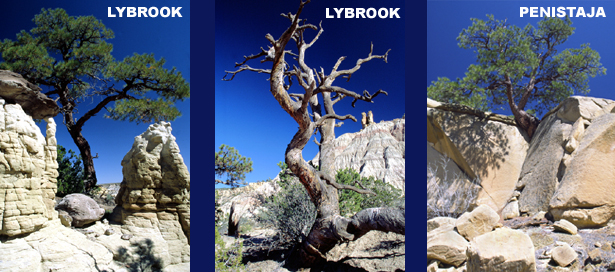
Significant differences exist between high desert vegetation growing in the two badlands groups. Fruitland/Kirtland badlands are almost completely devoid of plant life. Shallow, hard packed, sun baked, alkaline or salty soils shed water, discourage fragile seedlings, and make it difficult for root systems to get established.
Generally higher elevations and more varied topography in the Nacimiento badlands support a rich variety of hardy New Mexico high desert vegetation including wildflowers, various flowering shrubs, impressive, gnarled old junipers and tenacious, cliff hanging, picturesque “bonsai” ponderosa.
Shaded, protected Nacimiento box canyons collect soil and water, creating micro habitats that support a diverse flora and fauna. “ Badlands” is a judgmental term from a strictly human viewpoint. Animal and plant species density and diversity is often higher in some badlands than in the surrounding sagebrush flats. Plentiful rodents, reptiles, and insects living in the badlands provide food for raptors and coyotes.
In summary: the Fruitland/Kirtland badlands resemble abstract moonscapes, while the Nacimiento badlands are superbly xeriscaped sculpture gardens.
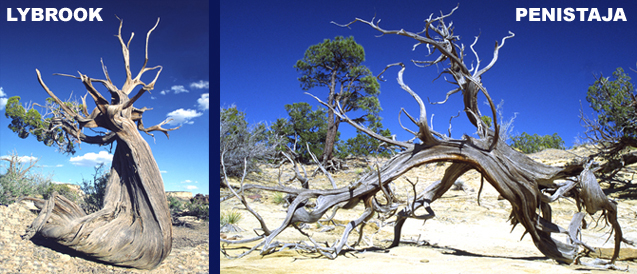
END OF GEOLOGY SECTION
| HOME |
GEOLOGY |
PHOTOGRAPHY TIPS | RECREATION | MAP - INDIVIDUAL BADLANDS |
| INDIVIDUAL BADLANDS PAGE | PHOTO TOURS |
BADLANDS OVERVIEW |
This site is property of PhotoTrekNM. All rights reserved. Copyright 2007.